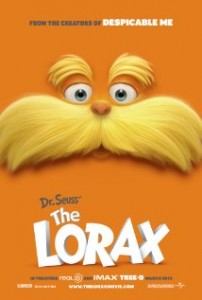
When parents read their children “The Lorax,” it is usually in the hopes that the kids will grow up with the desire to read, as well as learn how important it is to preserve and protect the environment. Dr. Seuss books have become classics because they often pack a double punch in that they entertain and instill a moral idea, all in a few pages. The question is, will today’s youth get that same moral responsibility when those ideas are presented on the big screen?
The 1971 story presents the idea of deforestation by way of corporate greed and human ignorance, all in a quirky, colorful way that could only be done by Seuss. However, this idea comes across as over-the-top in the cinema.
With an opening musical number that adults could probably appreciate, characters sing about how they don’t need trees, how wonderful polluted air is and that their town is just great the way it is. The problem is kids won’t always catch the sarcasm. This was not the only instance in which music softened the blow of the original message – when the Truffula trees begin to fall, it’s another musical number with bright colors and lyrics dripping with sarcasm.
Maybe this is not something that could have been avoided – after all, the obstacle to overcome with adapting a short story into a movie is figuring out how to pad the plot enough to make a full-length movie. Whereas the book doesn’t force some song-and-dance numbers on children, it is colorful enough to present the environmental message in a way that is still kid-friendly. Here, the educational theme suffered from time to time because of that. There is a half-developed love story used to cause young Ted Wiggins to become interested in trees.
There is, and I wish I were kidding, an instance where bottles of air are sold in a commercial exactly like beer would be sold, complete with the tag, “breathe responsibly.” The Once-ler, the man responsible for the destruction of the environment in the first place, is a young man with a cool hat and a sweet guitar for most of the movie. While he does showcase regret and remorse, my 22-year-old brain can’t get over his cool hat and sweet guitar, so I have to wonder how kids are taking this movie.
Holli Renfrow, mother of two from Paducah, Ky., took her son to see the movie.
“This was a story my mom read to me when I was little,” Renfrow said. “When I saw there was a movie coming out about it, I figured it would be a good way to get (my son) to get the idea of it.”
Though he is young, Renfrow’s son said something that resonated with my fears.
“You can jump through the (movie) screen, and you can start all over. Like no bad ever happened,” he said.
Like no bad ever happened? Ever happened?! “Saving the rain forest” has been the mantra of every kindergarten science class since even my time, yet here we are facing huge losses in the Amazon. You might have thought that, will all the attention the rain forest has gotten, it wouldn’t still need saving after all this time. I can’t speak for all viewers, but it would appear this child thinks an issue of global importance can be taken care of in an hour and a half. Great. As I said, I attribute this to the cinema. But what does that mean for the future of our environment?
If I learned anything from the movie, it’s that society needs humor, songs and a chase scene tacked on at the end to deal with hard-hitting issues. The message of taking responsibility for the world you love and live in is shrouded in humor, so I don’t think this movie should be viewed without a reading of the book as well. Maybe that’s just through the eyes of an increasingly pessimistic movie critic, but I worry that children are learning more from movies than from their parents and the books available to them.
Let me say I cannot stress this enough: read to your children. If you don’t have children, promise yourself that you will read to them. We cannot trust cartoon adaptation to deliver the original message of the book, though I don’t have a problem with seeing the movie.
Society cannot always trust what they know as adults, so my recommendation is this: see the movie when you get the chance. Live out the message long after the color and the credits have ended.